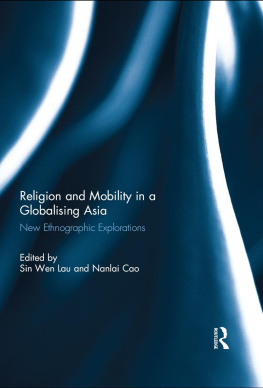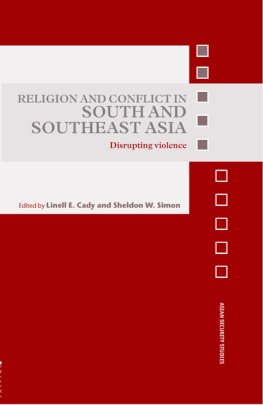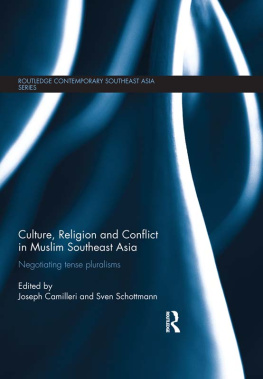Digital Culture and Religion in Asia
This book critically analyzes the functions and interconnectedness between religion and digital media in a range of East Asian countries. It discusses both how religious organizations make use of new technologies, and also explores how new technologies are reshaping religion in novel and interesting ways. Based on extensive research, the book focuses in particular on Christianity in South Korea, neo-Shintoism in Japan, Falun Gong in China and Islam in Southeast Asia. Offering a comparative perspective on a broad range of media practices including video gaming, virtual worship, social networking and online testimonials, the book also investigates the idea that use of technology in itself mirrors religious practices. With an analysis of the impact of religion and new technology on national consciousness in a range of geographical locations, the authors offer a broadening of the scope of the study of religion, culture and media.
Sam Han is Assistant Professor of Sociology at Nanyang Technological University (NTU) in Singapore and Adjunct Research Fellow at the Hawke Research Institute of the University of South Australia.
Kamaludeen Mohamed Nasir is Assistant Professor of Sociology at the Nanyang Technological University, Singapore.
Routledge Religion in Contemporary Asia Series
Series Editor: Bryan S. Turner, Professor at the City University of New York and Director of the Centre for Religion and Society at the University of Western Sydney
1 State Management of Religion in Indonesia
Myengkyo Seo
2 Religious Pluralism, State and Society in Asia
Edited by Chiara Formichi
3 Thailands International Meditation Centers
Tourism and the global commodifcation of religious practices
Brooke Schedneck
4 Digital Culture and Religion in Asia
Sam Han and Kamaludeen Mohamed Nasir
Digital Culture and Religion in Asia
Sam Han and Kamaludeen Mohamed Nasir
First published 2016
by Routledge
2 Park Square, Milton Park, Abingdon, Oxon OX14 4RN
and by Routledge
711 Third Avenue, New York, NY 10017
Routledge is an imprint of the Taylor & Francis Group, an informa business.
2016 Sam Han and Kamaludeen Mohamed Nasir
The right of Sam Han and Kamaludeen Mohamed Nasir to be identified as authors of this work has been asserted by them in accordance with sections 77 and 78 of the Copyright, Designs and Patents Act 1988.
All rights reserved. No part of this book may be reprinted or reproduced or utilised in any form or by any electronic, mechanical, or other means, now known or hereafter invented, including photocopying and recording, or in any information storage or retrieval system, without permission in writing from the publishers.
Trademark notice: Product or corporate names may be trademarks or registered trademarks, and are used only for identification and explanation without intent to infringe.
British Library Cataloguing in Publication Data
A catalogue record for this book is available from the British Library
Library of Congress Cataloging in Publication Data
Han, Sam, 1984-
Digital culture and religion in Asia / Sam Han and Kamaludeen Mohamed Nasir.
pages cm. -- (Routledge religion in contemporary Asia series ; 4)
ISBN 978-0-415-52185-7 (hardback) -- ISBN 978-1-315-74046-1 (e-book)
1. Digital media--Religious aspects. 2. Digital media--Asia.
3. Asia--Religion. 4. Information technology--Religious aspects.
5. Information technology--Asia. I. Title.
BL265.I54H36 2015
201.7--dc23
2015016099
ISBN: 978-1-138-85940-1 (hbk)
ISBN: 978-1-315-71726-5 (ebk)
There have been many who were vital in providing support during the course of this books researching, writing and production. What started as a conversation between Sam and series editor Bryan Turner in the lunchroom of the Graduate Center of the City University of New York, turned into a process that came to involve many others, without whom this book would have been impossible.
Firstly, we wish to thank Bryan and Peter Sowden of Routledge for their unending support for this project, which took a bit longer than expected. At Routledge, we also would like to acknowledge Emma Chappell and Carrie Bell, and the copyeditor Alison Neale, who helped improve the manuscript at various points. We are also grateful to our colleagues, administrative staff and students in the Division of Sociology at Nanyang Technological University in Singapore. Vinay Kumar deserves special mention for editorial and research assistance. Muhammad Adib Ramzali, Muhammad Ishaq Ebrahim, Victor Yiu and Nicholas Sim Hee Juat provided the photograph for the cover, for which we are grateful. Lastly, we would like to express our gratitude (and apologies) to our respective families.
While we acknowledge the helping hands of the aforementioned, mistakes, errors and insufficiencies in this book are our own.
Sam Han
Kamaludeen Mohamed Nasir
Singapore
The 3rd International Conference on Human Rights and Peace and Conflict in Southeast Asia occurred on October 16, 2014 like any other academic conference, for the most part. There were panels, keynote speeches and plenty of networking opportunities in the Swiss Garden Hotel in Kuala Lumpur, Malaysia, which played host. Indeed, while conferences, especially those of the academic variety, are hardly headline material, this one somehow resulted in a great deal of media coverage, the reason being an Indonesian scholar by the name of Ulil Abshar Abdalla. Scheduled to sit on a panel entitled Religion and human rights in Southeast Asia, Dr Ulil was, according to reports, denied entry just a few days earlier when he was scheduled to appear at another event, organized by the liberal Islamic Renaissance Front (IRF), a self-described intellectual movement and think tank focused on youth empowerment and the promotion of Muslim intellectual discourse (IRF n.d.). Due to his reputation for what detractors call liberal Islam, Ulil was not allowed to enter Malaysia. He was put on an immigration blacklist. Malaysias Minister of Home Affairs Datuk Seri Zahid Hamidi was quoted as saying that Ulil would mislead the Muslims in the country if he is allowed to spread his brand of liberalism here (Wong 2014). In order to circumvent an immigration kerfuffle, the organizers of the panel at the human rights conference had Ulil participate in the panel via Skype. In coming up with the idea for using Skype, Farouk Musa, the director of the IRF, who also participated in the panel, characterized it as a slap in the face to the government. As he said, In this age of technology, it is impossible for you [the government] to prevent ideas from being disseminated (TMI 2014).
This episode is one that is rather instructive for the purposes of introducing some of the themes and arguments contained in this book. The status of religion and new media in todays globalized world is well-trodden intellectual territory. The utilization of new media by any group, be it religious or not, should not come as a surprise. Yet, it still does for many, as Heidi Campbell, Jeremy Stolow and countless other scholars who have studied the nexus of digital media, culture and religion, have noted. The idea that religious groups and institutions are innately suspicious of technology and thus typically reject or strongly resist new forms, especially media technologies (Campbell 2010, 4) is still prevalent. This perspective is an extension of a certain modernist logic that conflates science and technology with rationalization. Accordingly, religion, and thus religious groups, as an uncomplicated remnant of the pre-modern past, it stands to reason, would not mesh well when attempting to harness the power of the product of scientific rationality. Science and technology are seen to be based on reason, logic, and what is seenwhile religion is seen to function in the realm of faith, the spiritual and the unseen (ibid., 4). Stolow (2005, 122) calls this the myth of social modernization.





